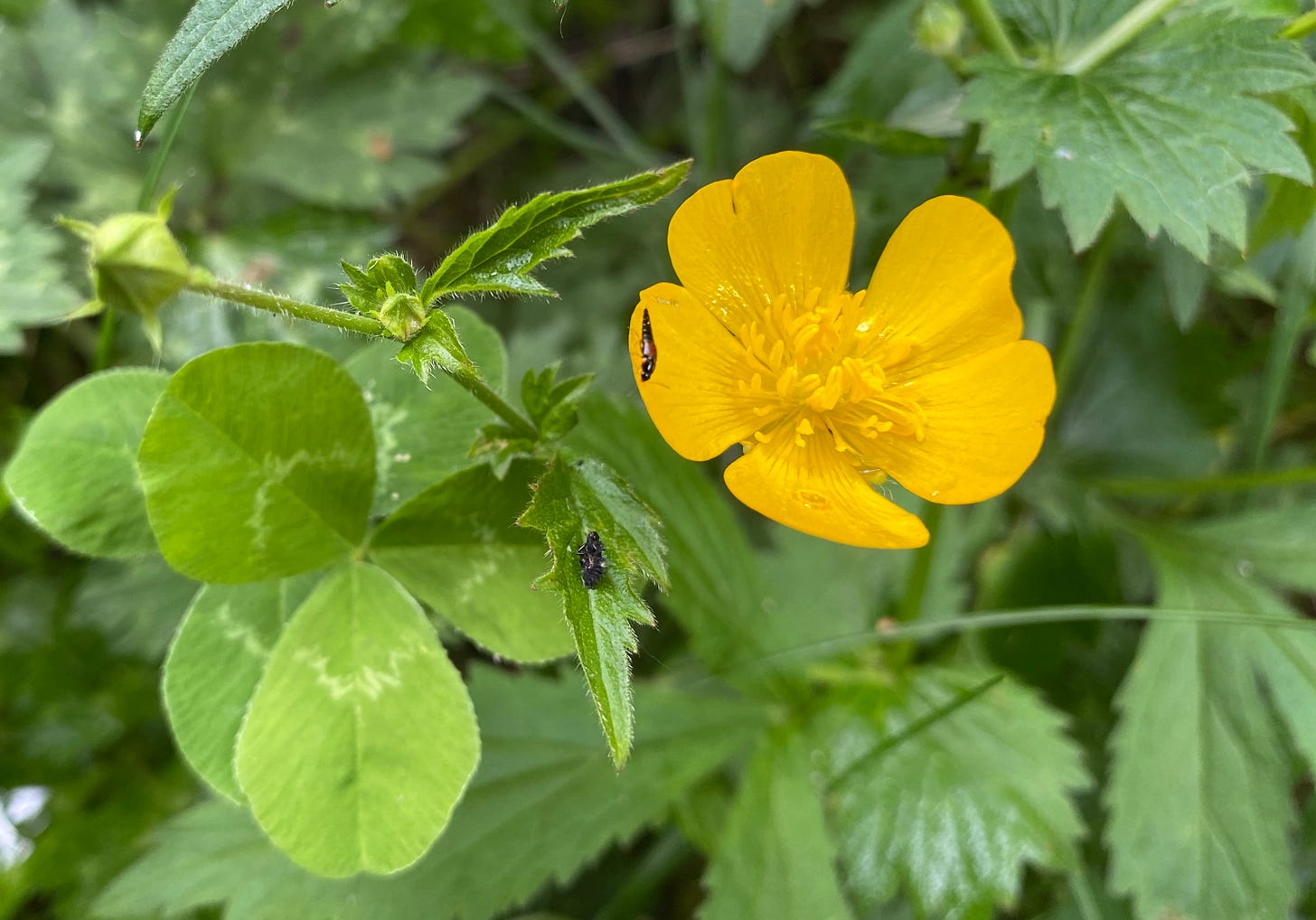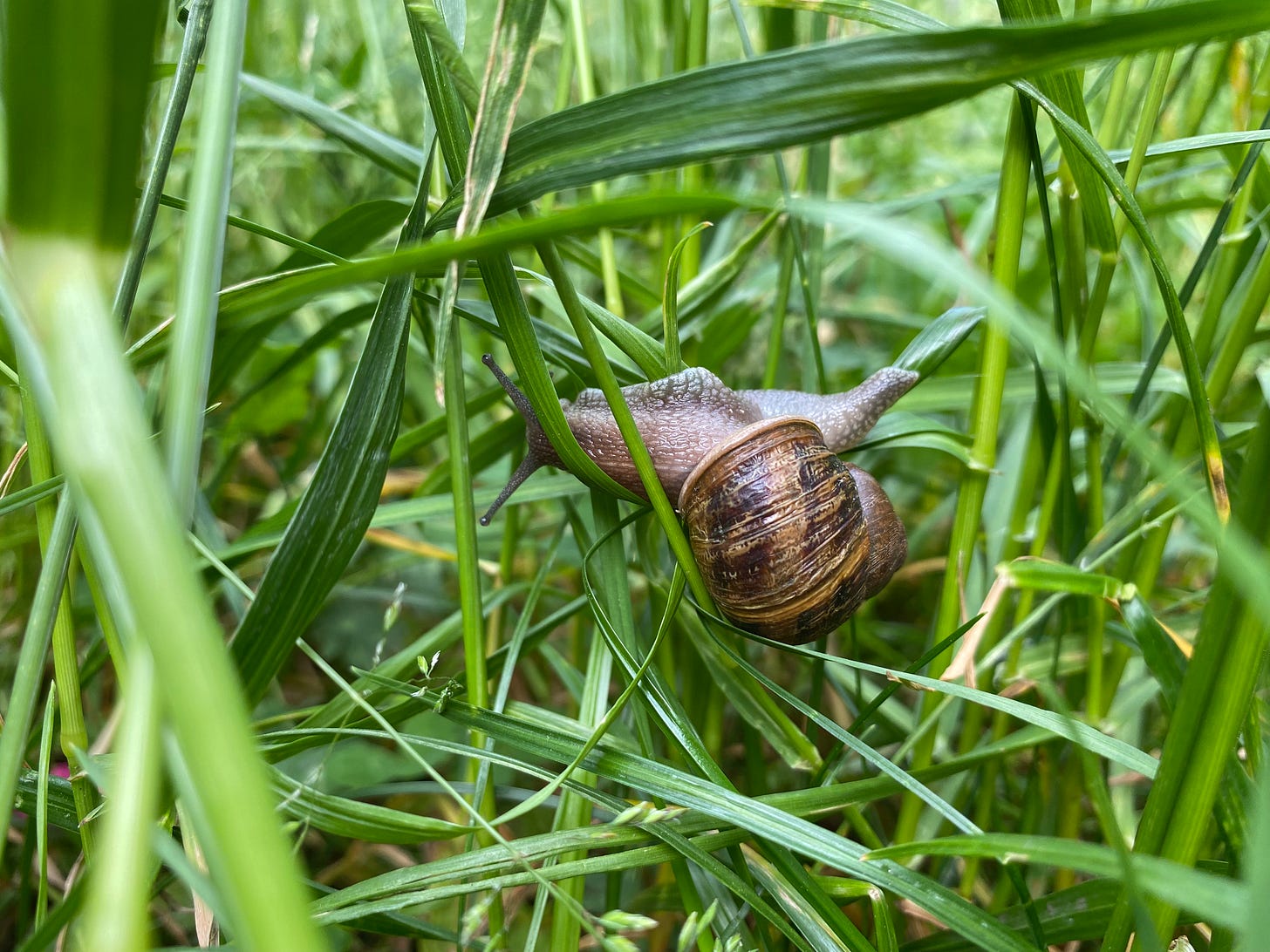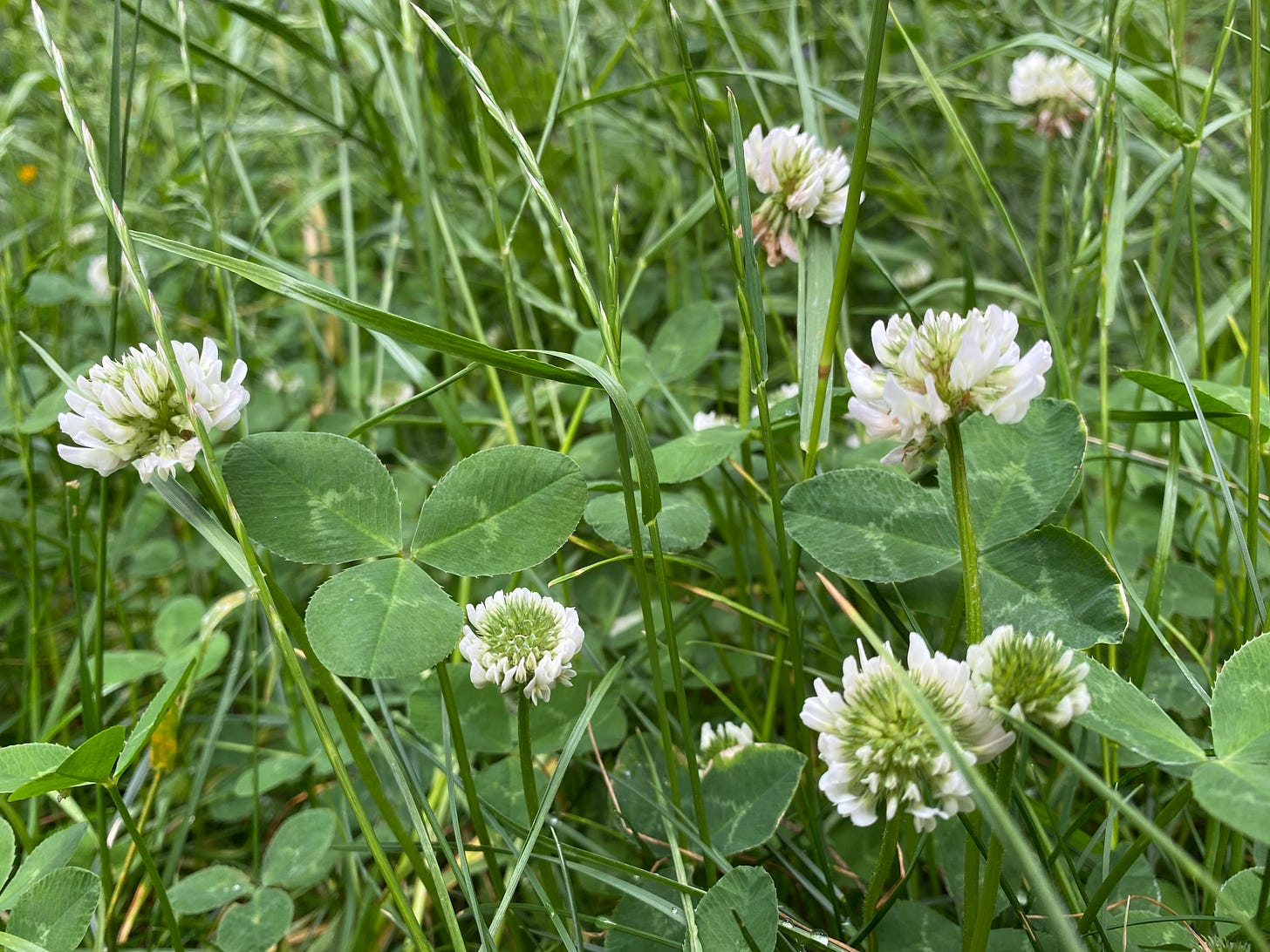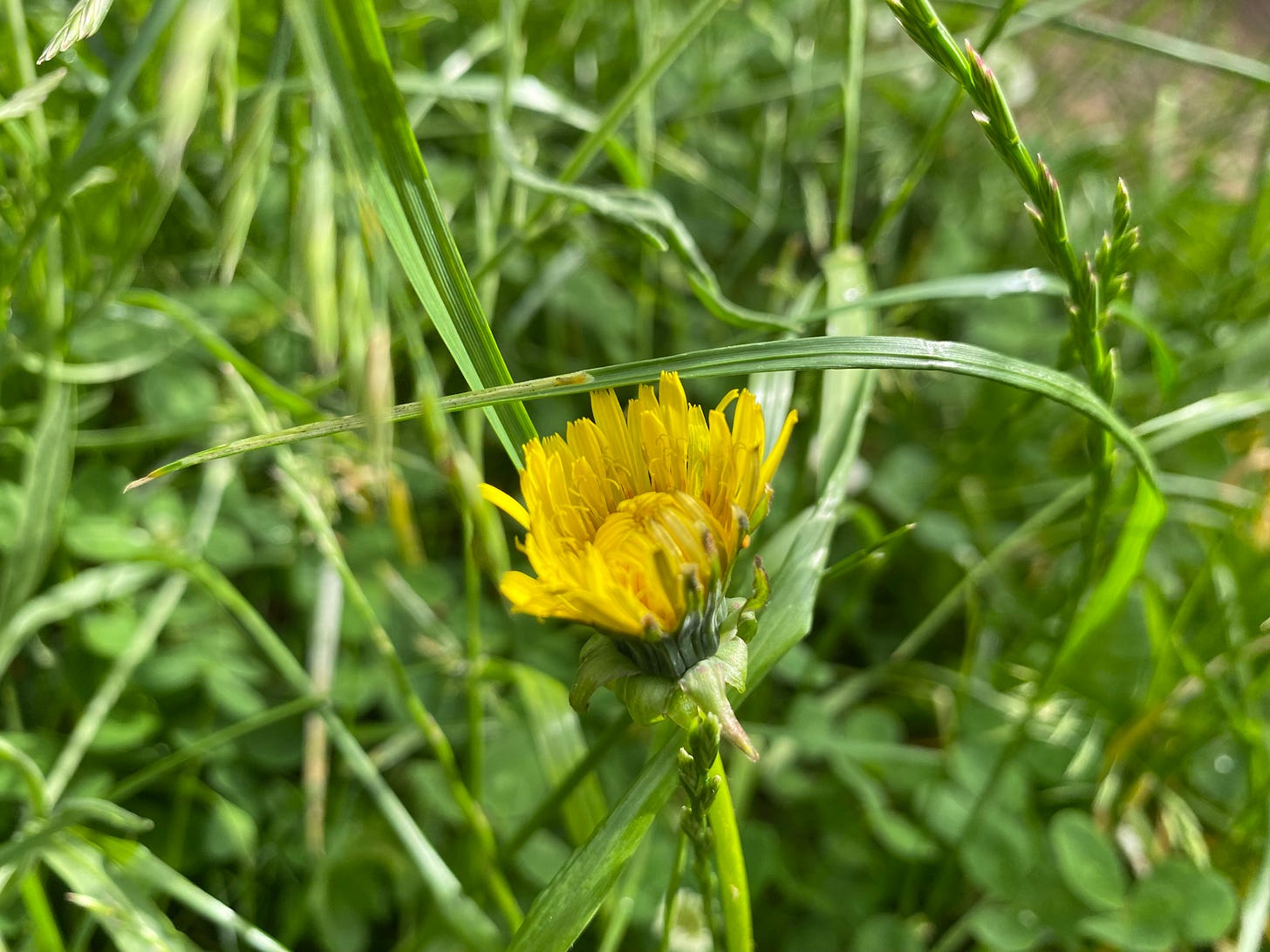No More No Mow May
The lawn has been left to grow long, wild and free – but has it been worth it? Plus: lots of lovely links
Hi, I’m Dan, and this is my alternative gardening newsletter, The Earthworm. Whether you’re a first-time reader or a long-time subscriber, thanks for being here. The Earthworm is a reader-supported publication. The two best ways you can support my work are to share this newsletter with a friend, and to consider upgrading to a paid subscription. And remember, the entire back catalogue of features, interviews, columns and more is freely available to all members of The Earthworm community. Why not take a scroll down memory lane?
No Mow May is no more. As regular readers will well remember, at the start of the month I wrote about the national campaign, spearheaded by the charity Plantlife, that encourages people to give their mowers, strimmers, edgers and shears a break during the month of May.
The campaign appealed to me for various reasons, not least that I could participate in grassroots action (so to speak) without lifting a finger, or even leaving my front door. But laziness aside, I also feel very passionately about the wider story that Plantlife are trying to communicate. Namely, that lawns are desolate wastelands for wildlife. I’m not even exaggerating when I say that a well-mown, well-weeded lawn offers about as much useful habitat to wildlife as bare tarmac.
Leave these lawns alone for a few weeks, however, and they can become shaggy shelters and swishy supermarkets for all manner of animal life, from the tiniest insects to frogs, newts and even hedgehogs.
No Mow May has had its downsides, of course. Since our patio is packed with pots, and we’re not blessed with anything as extravagant as a potting shed, the bulk of my active gardening has had to take place on the overgrown grass. The irony is not lost on me that, in doing so, I have invited invertebrates into a new wildlife haven, only then to stomp about on it like a sock-footed Godzilla, doing untold damage to their little homesteads.
The ex-lawn also looks a bit sorry for itself when trodden flat; leads to itchy shins when dry; soggy shins when wet; and is destined to look horrible when I do finally get round to giving it a trim.
So, has it been worth it? For the human residents of our household, arguably not. An overgrown lawn is, whilst fairly attractive in a mini-meadow sort of a way, not a comfortable place to inhabit. But as for the impact on our wild beneficiaries, I think it has been a triumph.

OK, so I haven’t seen any evidence of frogs, newts or hedgehogs. But there are many, many flowers – right now, almost exclusively creeping buttercup and white clover, with the odd dandelion here and there – which means a tasty feast for pollinators. (If you’ve been participating in No Mow May, don’t forget to log your floral findings on the Every Flower Counts survey.)
And these buzzily conspicuous pollinators are merely the tip of the insect iceberg. Peel back the foot-high blades of grass, lift the mottled leaves of the buttercups, and there are tons of tiny critters going about their business. I don’t know what half of them are, but that doesn’t matter – I let the lawn grow wild and I welcomed in all-comers, no questions asked. And here they are.
The questions now are: when do I give it the chop? And how guilty will I feel when I do?

Have you been taking part in #NoMowMay? If so, have you been surprised by any of the wildflowers or wildlife visitors that have appeared in your garden as a result? Will you do it again next year? I’d love to know how you got on.
Last week, the grounds of the Royal Hospital Chelsea were draped in pretty flowers; today, it is a building site. Or rather, a demolition site. The floaty dresses and open-toed sandals are out; the high vis vests and steel-capped boots back in.
If you are sick to death of hearing about the jewel in the RHS’s crown, then maybe keep scrolling. But if you live for analysis, feast on controversy, and get high on hot takes, then check out some of these links.
On The Earthworm
Last week, I brought you daily coverage from the Chelsea Flower Show. In case you missed any of it, here’s a breakdown. On day one, I reported on the distracting theatricality and starry sensory overload that was press day. Day two shone the spotlight on five young designers making their Chelsea debuts.
Did you see my interview with Chelsea Pensioner Peter Birch, for whom the Chelsea showground is home? If not, check it out on the coverage from day three. On day four, I brought you inspiration and advice from gold medal-winning growers from inside the Great Pavilion. And finally, on day five, I shared the nine lessons I learned from my inaugural experience at Chelsea.
On The Internet
Fellow Substacker, former Earthworm interviewee, and all-round lovely person Jo Thompson was one of the RHS judges at this year’s show, and has herself won many a medal at Chelseas past. In this post, she reveals some of the behind-the-scenes stresses and strains involved in getting a show garden ready for judging.
Meanwhile, the majority of non-news and non-trends coverage that I’ve been consuming has been considerably more critical about not just this year’s event, but the very existence of the Chelsea Flower Show. Houseplant guru Jane Perrone wrote a fascinating blog post all about why your garden will never look like those on Main Avenue, where she reveals some tricks of the show garden trade that might surprise and/or shock you.
Continuing on that theme, Sui Searle – who has herself in the past been involved in the creation of show gardens – writes over on Radicle about changing priorities, the judging process, and whose approval we should really care about. And finally, on the Roots and All podcast, the tables are turned on usual host Sarah Wilson, who in this special episode is herself interviewed about the phenomenon – and future – of the show garden.
And finally…
Unless you have been living a) under a rock, or b) somewhere other than the British Isles, you will be aware that this coming Thursday and Friday are public holidays here in the UK, owing to the platinum jubilee celebrations.
Well, I have decided to do what 99% of my fellow countryfolk will be doing, and take the days off. As such, there will be no Earthworm this Friday, June 3rd. I hope you won’t begrudge me the break. Normal service will resume on Tuesday.
If you too have a long weekend to look forward to, then I hope you enjoy it. Find a rose, give it a sniff, and celebrate the glory and majesty of her very royal highness: Mother Nature.







I like the idea of No Mow May not so much as an annual ritual, but as an awareness campaign that inspires individual gardeners/homeowners to make changes to their landscape. What I mean by that is, taking part can help someone see how leaving the land alone can benefit wildlife. Most of us would be unable to live with un-mown grass all year long, but we might be able to segment off an area that is left to go wild. Even a seemingly small action like that can help.
Well, I have to admit that by the time my husband and I undertook the enormous task of mowing yesterday (it had to be yesterday, because the only way we could deal with the amount of work was to make it happen on a day off, and it was Memorial Day in the U.S.), I was not so enamored with our little experiment. Raking up all the extra grass from TWO ACRES OF LAWN was humbling, and that's a nice word for it. I wrecked my back and got a terrible sunburn. It took my husband, even though he got to ride around on a motorized vehicle, twice as long to cut as normal, which made us both wonder about the pollution savings of not mowing for a month but then running the mower for four straight hours at the end. By evening, we were unable to even have a conversation about whether we will do it again next year. We saw a few more wildflowers -- and I swear there were more butterflies around than normal -- but otherwise it didn't seem to make a huge difference. (We have a lot of wildlife that travels through our yard to get to a large county park with a lake just down the road, so there are all kinds of animals regardless of what we do.)
I'm glad we tried it. But I will have to think long and hard about whether or not I'm willing to do it again next year (and it will take an act of God to convince my husband -- not impossible, I'm very persuasive 😉, but I need to recover first).